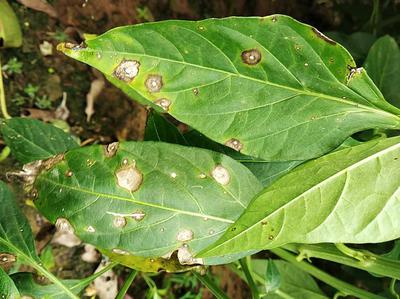Chilli Cercospora Leaf Spot
Cercospora capsici
Fungus
In a Nutshell
- Large concentric brown spots on leaves with whitish center, dark ring and yellow halo ('frog eye').
- Spots enlarge to become large lesions.
- Yellowing and dropping of leaves, exposing fruits to sunscald.
Can also be found in
Symptoms
During the initial stage of infection, brownish circular spots with light-gray centers and reddish-brown margins appear on leaves. Later on, they develop into large circular tan spots, up to 1.5 cm in size, formed by dark concentric rings growing around a whitish center. A rough dark ring and a yellow halo gives the spots the characteristic 'frog-eye' appearance. As the spots become more numerous, they gradually coalesce to form large leaf lesions. The white center often dries and falls out, leaving a ‘shot-hole’ effect. At later stages of the infection, leaves turn yellow and wilt or drop, exposing fruits to sunscald. In severe cases, spots can also be observed on fruit stalk and calyx, often resulting in stem-end rot.
Recommendations

Organic Control
Seed treatment with hot water at 52°C for 30 minutes is a way to reduce the presence of the fungus on seeds. Note that the treatment may also affect seed germination if not carried out properly (excessive time or temperature). Foliar spray of products containing copper hydroxide can be done, starting when the spots first appear, and continue at 10-14 days intervals until 3-4 weeks before the last harvest. It is important to spray both sides of the leaves.

Chemical Control
Always consider an integrated approach with preventive measures together with biological treatments if available. Seed treatment with captan (3g/kg) works fine to fight the disease. Other treatments to control this disease include foliar spray of products containing copper hydroxide, chlorothalonil or mancozeb. Treatment should start when the spots first appear and continue at 10-14 days intervals until 3-4 weeks before the last harvest. It is important to spray both sides of the leaves.
What caused it?
The symptoms are caused by Cercospora capsici, a fungus that is particularly resilient in the tropics, affecting plants both in seedbeds and fields. It survives from one season to the other in or on seeds, in the soil and also on infected plant residues. It spreads via water, rain, wind and leaf-to-leaf contact and on implements, tools and workers. Foliar infection occurs by direct penetration of the leaf and is favored by prolonged leaf wetness. Optimal conditions for infection are warm temperatures around 23 °C and relative humidity of 77-85%. If these conditions are met, it is very likely to affect yields significantly, particularly if the infection takes place at the beginning of the season.
Preventive Measures
- Make sure to acquire healthy, certified seeds.
- Space plants as recommended to allow for good air circulation and to avoid extended periods of leaf wetness.
- Use mulch to create a physical barrier between the plant and fungus.
- Use stakes to keep plants upright.
- Use a drip irrigation system to minimize leaf wetness.
- Monitor seedbeds, young plants or transplants for any symptoms of the disease.
- Remove infected plants and destroy them away from the field.
- Control susceptible weeds in and around the field.
- Do not work on fields when plants are wet.
- Implement wide crop rotation, at least over a 3-year period.
- Remove plant debris after harvest and destroy them.
- Make sure fruits selected for seed do not have stem-end rots.



